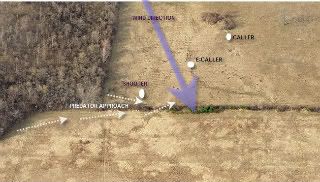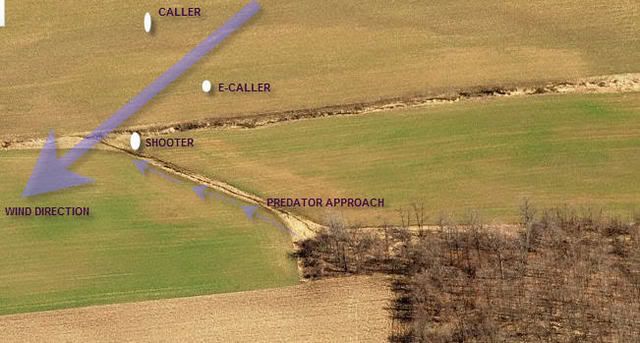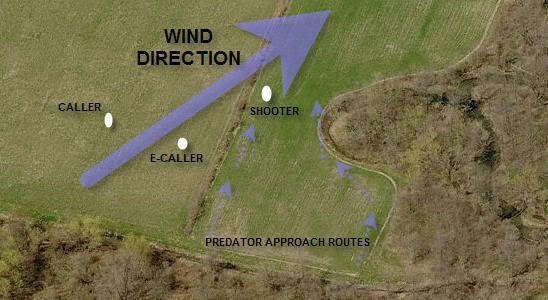Post by andrew lewand on Jan 24, 2010 14:51:31 GMT -5
Although the system is geared towards the night hunter, it has been found to be highly effective when used during day light hours with a decoy for added effect. There are three main elements involved in the technique… They are the Calling Sequence, the Set Up and the Equipment. To best understand the entire system, we shall discuss each element separately.
As mentioned, the calling portion of the system was developed to combat call-wise predators. In essence, it is a two-tiered sound approach, with two distinctly different volume levels, that really gets the predators attention and makes them want to investigate the situation. The actual calling sequence involves using an electronic call and a mouth call simultaneously. The electronic call is placed out at a distance of 40-80 yards, depending upon the landscape. The sound selection should be something other than rabbit distress. Grey fox pup distress and coyote pup distress are the calls of choice (It should be noted that high frequency bird distress calls also proved successful from the electronic calls). The real trick here is to play the electronic call softly. The volume should be set so that the hunter operating the call can hear the unit emit the sounds – but not so loud that it is echoing in the landscape. It is recommended to set the volume at one-quarter to one-half of maximum level. The hunter should also allow the electronic call to play continuously… do not turn the sound off for the entire stand. As the electronic call is playing the hunter should intermittently use a mouth/hand call. The choice of call can be any distress and the tip here is to blow the call loud and with full emotion. With the two calls emitting at the same time, there is a sensory overload occurring and it seems as if the coyotes and/or fox that approach are expecting a real ruckus in the area. These are the predators that charge in expecting to take advantage of the situation and get an easy free meal. On the other hand, the predators may come in slower and “hang up” out of gun range to survey the situation. These educated critters received their degrees from the school of hard knocks and near misses. They know something sounds good, but they are too wise to fully commit. Normally, the hunter would attempt to squeak-in these wise dogs, often with mixed results. Not to worry, the system has taken these critters into account. When properly executed, the system has the predators “hanging up” right in the lap of the shooter. The details are in the set up philosophy.
According to McDonald, the set up portion of this system is even more important than the unique calling sequence. The system’s set up strategy was developed to capitalize on the natural prey seeking behaviors of coyotes and foxes. It is based on the premise that educated predators, coyotes especially, would not commit to open fields, even under the cover of night time darkness. The predators would utilize all forms of concealment in their approach and not allow themselves to be seen by hunters who were using conventional set up positions. It is no surprise to any hunter to use the wind to your advantage. However, the set up details in this system take things one step further by allowing the wind direction to assist the hunter is making a killing shot. The system can be used effectively when hunting in pairs or by solo hunters.
The trick is to allow the predator to approach your calling while using a travel corridor where they feel safe and comfortable. Examples of such safe routes include hedgerows, un-mowed grass strips, ditches, etc. Position your self using a crosswind so that the wind blows towards the travel corridor. Remember, this is the area where they feel comfortable and also will go to use their sharp sense of smell as a defense as they approach. When hunting with a partner, position the shooter downwind, just off the travel corridor. For shotgun users, setting up 30-40 yards off the travel corridor has proved to be most effective. Rifle shooters should extend the distance to 50-75 yards away from the corridor. Take caution to assure that the shooters position allows him to get a shot opportunity before approaching predators scent him in the wind. The accompanying diagrams will clarify the desired positions of the caller and the shooter in relationship to the predator travel corridors.
When hunting solo, a hunter can still take advantage of this set up logic. The tip here is to place the remotely placed call in the open field and sit near and wait near the travel corridor. By doing so, the hunter is now downwind of the call source. In this situation, the solo hunter is mimicking the 2-person strategy all by himself. This is perhaps the greatest attribute to electronic calls with remote controls.
The photos below (supplied by Matt McDonald) illustrate the set up technique. Apply the principles to your hunting areas.



As mentioned, the calling portion of the system was developed to combat call-wise predators. In essence, it is a two-tiered sound approach, with two distinctly different volume levels, that really gets the predators attention and makes them want to investigate the situation. The actual calling sequence involves using an electronic call and a mouth call simultaneously. The electronic call is placed out at a distance of 40-80 yards, depending upon the landscape. The sound selection should be something other than rabbit distress. Grey fox pup distress and coyote pup distress are the calls of choice (It should be noted that high frequency bird distress calls also proved successful from the electronic calls). The real trick here is to play the electronic call softly. The volume should be set so that the hunter operating the call can hear the unit emit the sounds – but not so loud that it is echoing in the landscape. It is recommended to set the volume at one-quarter to one-half of maximum level. The hunter should also allow the electronic call to play continuously… do not turn the sound off for the entire stand. As the electronic call is playing the hunter should intermittently use a mouth/hand call. The choice of call can be any distress and the tip here is to blow the call loud and with full emotion. With the two calls emitting at the same time, there is a sensory overload occurring and it seems as if the coyotes and/or fox that approach are expecting a real ruckus in the area. These are the predators that charge in expecting to take advantage of the situation and get an easy free meal. On the other hand, the predators may come in slower and “hang up” out of gun range to survey the situation. These educated critters received their degrees from the school of hard knocks and near misses. They know something sounds good, but they are too wise to fully commit. Normally, the hunter would attempt to squeak-in these wise dogs, often with mixed results. Not to worry, the system has taken these critters into account. When properly executed, the system has the predators “hanging up” right in the lap of the shooter. The details are in the set up philosophy.
According to McDonald, the set up portion of this system is even more important than the unique calling sequence. The system’s set up strategy was developed to capitalize on the natural prey seeking behaviors of coyotes and foxes. It is based on the premise that educated predators, coyotes especially, would not commit to open fields, even under the cover of night time darkness. The predators would utilize all forms of concealment in their approach and not allow themselves to be seen by hunters who were using conventional set up positions. It is no surprise to any hunter to use the wind to your advantage. However, the set up details in this system take things one step further by allowing the wind direction to assist the hunter is making a killing shot. The system can be used effectively when hunting in pairs or by solo hunters.
The trick is to allow the predator to approach your calling while using a travel corridor where they feel safe and comfortable. Examples of such safe routes include hedgerows, un-mowed grass strips, ditches, etc. Position your self using a crosswind so that the wind blows towards the travel corridor. Remember, this is the area where they feel comfortable and also will go to use their sharp sense of smell as a defense as they approach. When hunting with a partner, position the shooter downwind, just off the travel corridor. For shotgun users, setting up 30-40 yards off the travel corridor has proved to be most effective. Rifle shooters should extend the distance to 50-75 yards away from the corridor. Take caution to assure that the shooters position allows him to get a shot opportunity before approaching predators scent him in the wind. The accompanying diagrams will clarify the desired positions of the caller and the shooter in relationship to the predator travel corridors.
When hunting solo, a hunter can still take advantage of this set up logic. The tip here is to place the remotely placed call in the open field and sit near and wait near the travel corridor. By doing so, the hunter is now downwind of the call source. In this situation, the solo hunter is mimicking the 2-person strategy all by himself. This is perhaps the greatest attribute to electronic calls with remote controls.
The photos below (supplied by Matt McDonald) illustrate the set up technique. Apply the principles to your hunting areas.









 . I can see why Andrew was asking early in the season about continuing. Everyone have a great off season ! Congrats to all the successful hunters this 2023-24 season
. I can see why Andrew was asking early in the season about continuing. Everyone have a great off season ! Congrats to all the successful hunters this 2023-24 season